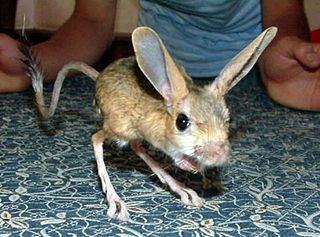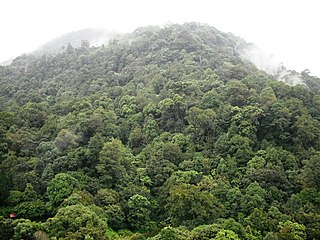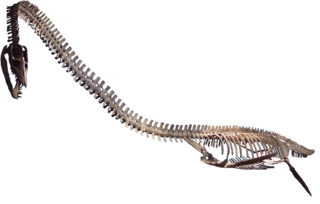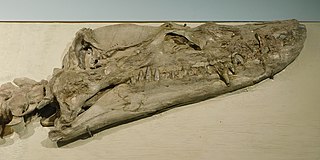
Jerboas are hopping desert rodents found throughout North Africa and Asia, and are members of the family Dipodidae. They tend to live in hot deserts.

Diplodactylus is a genus of geckos of the family Diplodactylidae from Australia. They are sometimes called stone geckos or fat-tailed geckos. Member species are morphologically similar but genetically distinct.

The South Western Ghats montane rain forests is an ecoregion in South India, covering the southern portion of the Western Ghats in Karnataka, Kerala and Tamil Nadu at elevations from 1,000 to 2,695 m. Annual rainfall in this ecoregion exceeds 2,800 mm (110 in).

Elasmosaurus is a genus of plesiosaur that lived in North America during the Campanian stage of the Late Cretaceous period, about 80.5 million years ago. The first specimen was discovered in 1867 near Fort Wallace, Kansas, US, and was sent to the American paleontologist Edward Drinker Cope, who named it E. platyurus in 1868. The generic name means "thin-plate reptile", and the specific name means "flat-tailed". Cope originally reconstructed the skeleton of Elasmosaurus with the skull at the end of the tail, an error which was made light of by the paleontologist Othniel Charles Marsh, and became part of their "Bone Wars" rivalry. Only one incomplete Elasmosaurus skeleton is definitely known, consisting of a fragmentary skull, the spine, and the pectoral and pelvic girdles, and a single species is recognized today; other species are now considered invalid or have been moved to other genera.

Dipodoidea is a superfamily of rodents, also known as dipodoids, found across the Northern Hemisphere. This superfamily includes over 50 species among the 16 genera in 3 families. They include the jerboas, jumping mice, and birch mice. Different species are found in grassland, deserts, and forests. They are all capable of saltation, a feature that is most highly evolved in the desert-dwelling jerboas.

The flat-tailed house gecko, also known as the frilled house gecko or Asian house gecko, is a species of Gekkonidae native to southeastern and southern Asia. The species is sometimes classified under the genus Cosymbotus.

Hylopetes is a genus of flying squirrels. There are about 10 species.

Schoenicola is a genus of Old World warbler in the family Locustellidae. There are two species, both from peninsular India. The genus has been placed in the subfamily Megalurinae.

The broad-tailed grassbird is a species of Old World warbler in the family Locustellidae. It is endemic to the Western Ghats of India with a possibility of occurrence in Sri Lanka. A small, mostly brown bird, it has a broad rounded and graduated tail. It is found only on the higher altitude grassy hills where it usually skulks, except during the breeding season when males fly up into the air to sing in their display. The species is believed to be a resident although it is possible that they make local movements.
Pygeretmus is a genus of rodent in the family Dipodidae. It contains the following species:
The dwarf fat-tailed jerboa is a species of rodent in the family Dipodidae. It is found in China, Iran, Kazakhstan, Mongolia, and Russia. They mostly reside in desert environments which can explain their size. They go long periods of time without food and water, which means they need a lower metabolic rate, and can be a reason for their size.
The greater fat-tailed jerboa is a species of rodent in the family Dipodidae. It is endemic to Kazakhstan. Its natural habitat is temperate desert.

Allactaginae is a subfamily of rodents.

Styxosaurus is a genus of plesiosaur of the family Elasmosauridae. Styxosaurus lived during the Campanian age of the Cretaceous period. Three species are known: S. snowii, S. browni, and S. rezaci.

Alaungdaw Kathapa National Park is a national park in Myanmar covering 541.6 sq mi (1,403 km2). It was established in 1989 and is listed as one of the ASEAN Heritage Parks. It spans an elevation of 443–4,380 ft (135–1,335 m) in the Kani and Mingin Townships in Sagaing Region.
Allophroides is a genus of the parasitic wasp family Ichneumonidae. The type species is Allophroides boops.

The Jentink’s flying squirrel is a species of squirrel native to Indonesia and Malaysia. They are nocturnal omnivores, and have an average body length of 131.27 mm and an average body mass of 56.98 grams.












